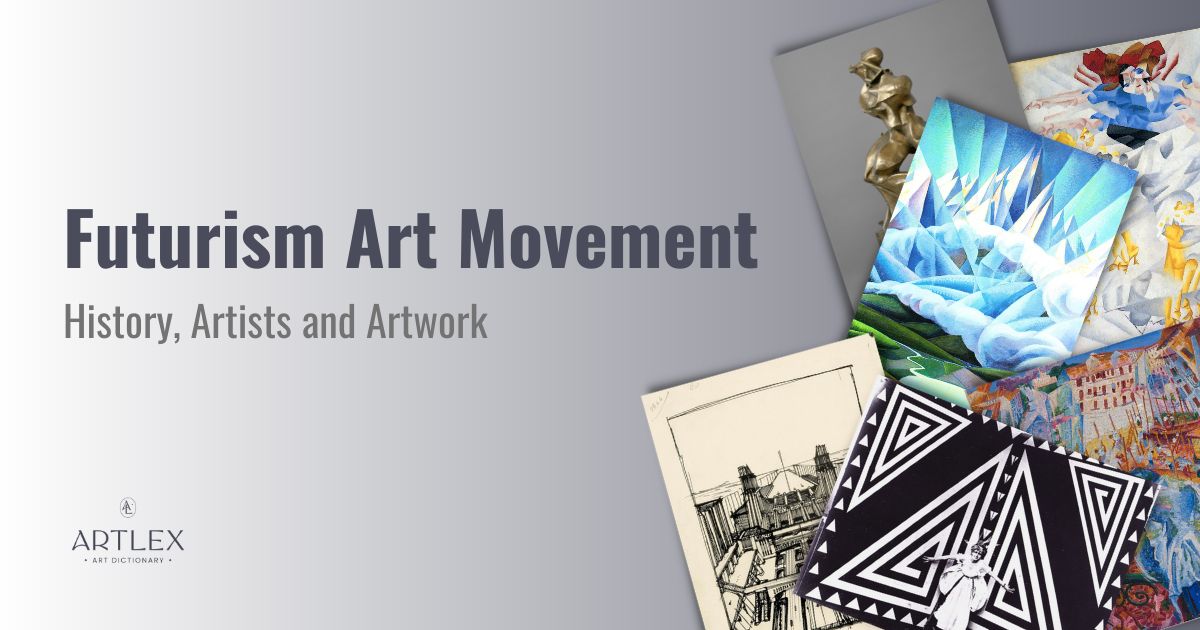
This article will cover a brief overview of the historical development of Italian futurism as well as the dominant component of the ideology represented by futurists and related to the cult of youth, industrialization, speed, technology, and modernization. The roles of the most important futurist artists such as Umberto Boccioni, Giacomo Balla and Carlo Carrà are analyzed. An analysis of the relation between futurism and cubism and futurism and modernism is also presented.
What is Futurism?
Futurism is an avant-garde art and social movement that originated in Italy. The key document for the development of futurism is the Manifesto of Futurism, which was published by Filippo Tommaso Marinetti in 1909. Several manifestos were created in the wake of futurist philosophy. All these manifestos had a common attitude towards the past based on uncompromising rejection, while glorified the cult of youth, industrialization, speed, technology, and modernization, often emphasizing the violent component of the struggle for cultural and wider social change. Futurism developed in literature as well as in painting, sculpture, architecture, industrial design, music, film, dance, and fashion.
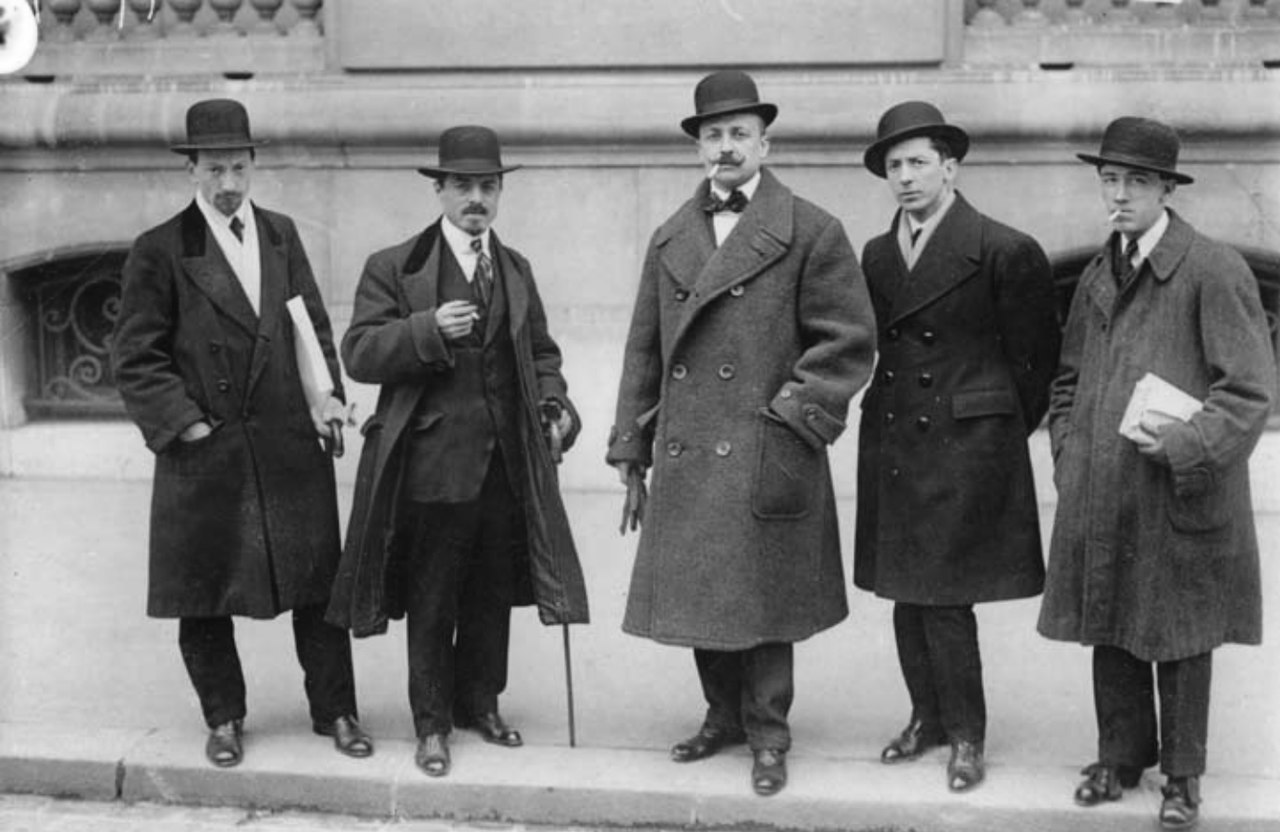
History of Futurism
Filippo Tommaso Marinetti, an Italian poet, founded the Futurist movement in Milan in 1909. He was soon joined by painters Umberto Boccioni, Carlo Carrà, Giacomo Balla, and Gino Severini who would define the visual poetics of futurism in later years. The Technical Manifesto of Futurist Painting was first published in 1910 in Milan. This document introduces the philosophy of futurism into the medium of painting by developing the concept of universal dynamism. In addition to Boccioni, the manifesto was signed by Carlo Carrà, Giacomo Balla, Luigi Russolo and Gino Severini. In the domain of formal aspects of painting, the futurist painters relied on the experiences of post-impressionists and cubists. The post-impressionist method – divisionism for the futurist painters was crucial. The basis of the divisionist paintings creation can be summed up in two procedures. The first is the application of pure or unmixed color pigment on the canvas and the second is the confrontation of the desired pairs of complementary colors in order to achieve maximum brightness. Secondly, the analytical principles of cubist painting, ie the fragmentation of scenes, enabled the realization of the desired dynamics within the painting.
The spectrum of influences of futurist ideas is very wide and refers to both avant-garde movements and modernism in a broader context. These influences are visible in Surrealism, Art Deco, Cubo-futurism, Constructivism, Rayonism, Vorticism and Precisionism.
Characteristics of Futurism
The characteristics of Futurism include: the rejection of traditional value frameworks in the field of culture, ie striving for art freed from the weight of its past, highlighting youth as a key capital of social development, as well as a fascination with technology, modernization of urban spaces and the dynamism of industrial plants.
Futurism Artists
The most notable futurism artists include: Umberto Boccioni, Giacomo Balla and Carlo Carrà.
Umberto Boccioni
Umberto Boccioni was a painter and sculptor, as well as a leading theorist of the Futurist Movement. Boccioni studied at the Accademia di Belle Arti in Rome. In addition to the Manifesto of Futurist painters, Boccioni published Futurist painting and sculpture (plastic dynamism) in 1914, which forms the basis for understanding futurist visual poetics. His works can be found in the Peggy Guggenheim Collection in Venice, the Museum of Modern Art in New York, and the Metropolitan Museum of Art in New York.
Giacomo Balla
Giacomo Balla was a painter, caricaturist, poet and designer. Balla introduced the technique of divisionism into a futurist painting by influencing Umberto Boccioni and Gino Severini. His painting is characterized by the study of movement and light. Balla’s works are displayed in The Albright – Knox Art Gallery in New York, the Peggy Guggenheim Collection in Venice, and the Estorick Collection of Modern Italian Art in London.
Carlo Carrà
Carlo Carrà is one of the leading figures of Italian futurism. He studied at the Brera Academy in Milan and was one of the signatories of the Manifesto of Futurist Painters. He later developed metaphysical painting with Giorgio de Chirico. His works are in the collections of the Galleria Nazionale d’Arte Moderna in Rome, the Museum of Modern Art in New York, and the Pinacoteca di Brera in Milan.
A full list of Futurism artists can be found below:
- Umberto Boccioni
- Giacomo Balla
- Carlo Carrà
- Gino Severini
- Elena Guro
- Giorgio Morandi
- Joseph Stella
- Aleksandra Ekster
- Valentine de Saint-Point
- Vsevolod Meyerhold
- Ivo Pannaggi
- Amadeo de Souza Cardoso
- Marcel Janco
- Luigi De Giudici
- Emilio Pettoruti
- Alexander Bogomazov
- David Bomberg
- Wanda Wulz
- Stenberg brothers
- Sante Monachesi
- Guilherme de Santa-Rita
- Primo Conti
- Otakar Švec
- Marisa Mori
- Stanley Cursiter
- Carlos Filipe Porfírio
- Enzo Mainardi
- Giuseppe Balbo
- André Fau
- Piergiorgio Colautti
- Severo Antonelli
Futurism Artwork
Umberto Boccioni, The Street Enters the House, 1912
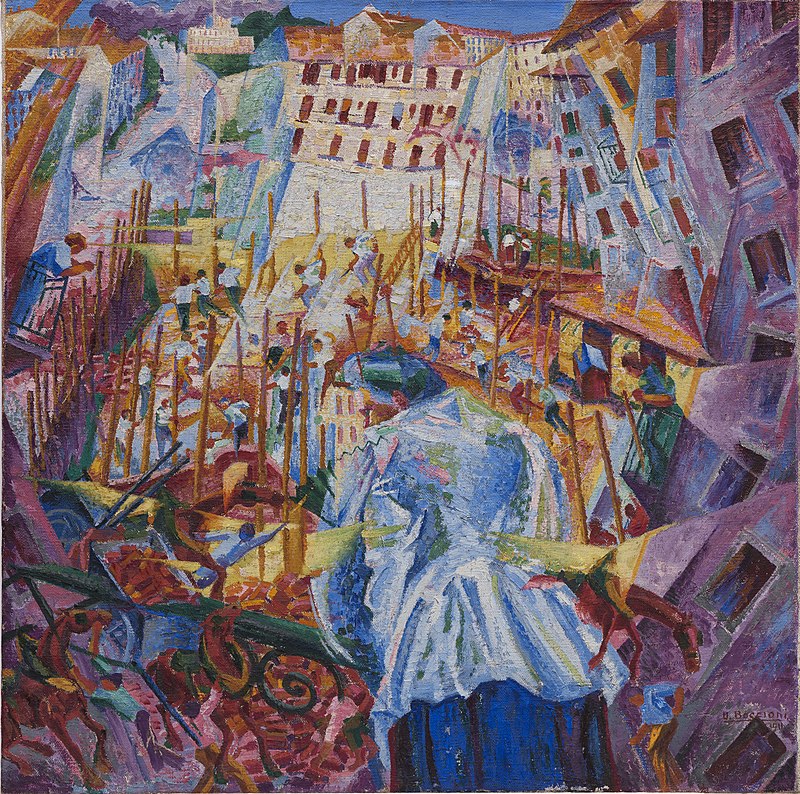
Oil on canvas, 100.0 cm × 100.5 cm, Sprengel Museum, Hanover
Gerardo Dottori, Ascending Forms (or Ascending Forces), 1930
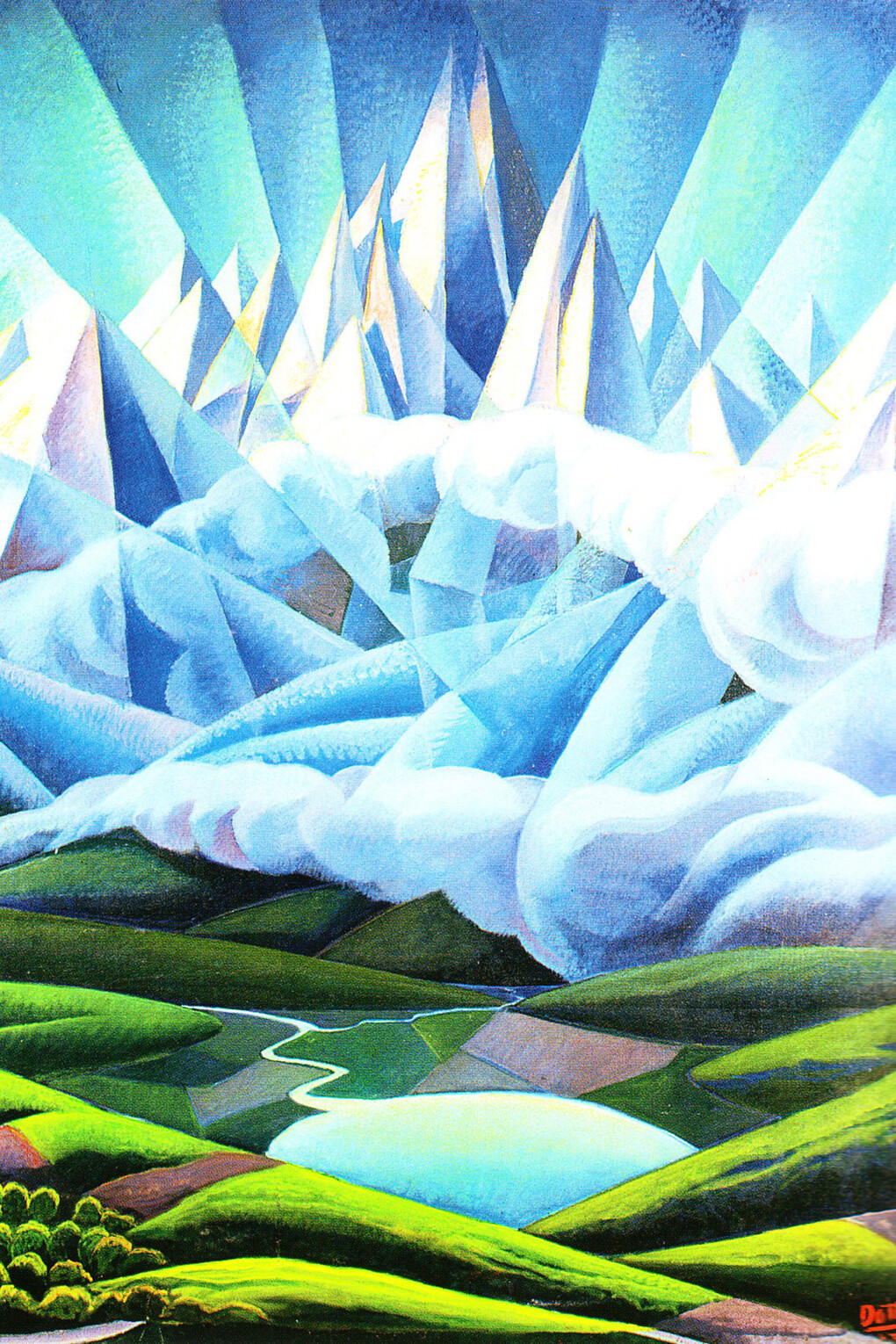
Oil on canvas, 188 x 143.5 cm, Civic Museum of Palazzo della Penna, Perugia
Gino Severini, Dynamism of a Dancer, 1912.
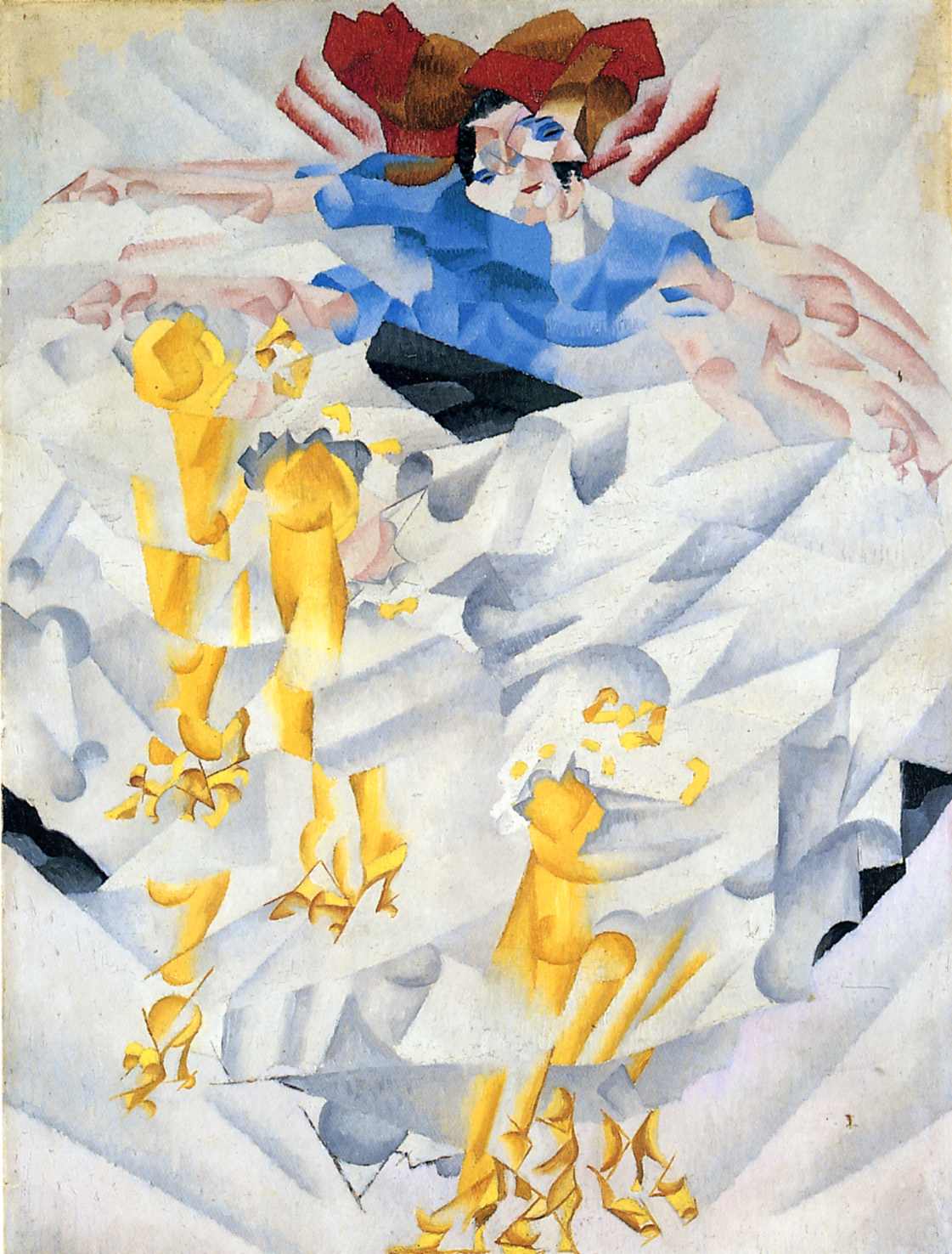
Oil on canvas, 60 x 45 cm, Pinacoteca di Brera, Milan
Umberto Boccioni, Unique Forms of Continuity in Space, 1913, cast 1950
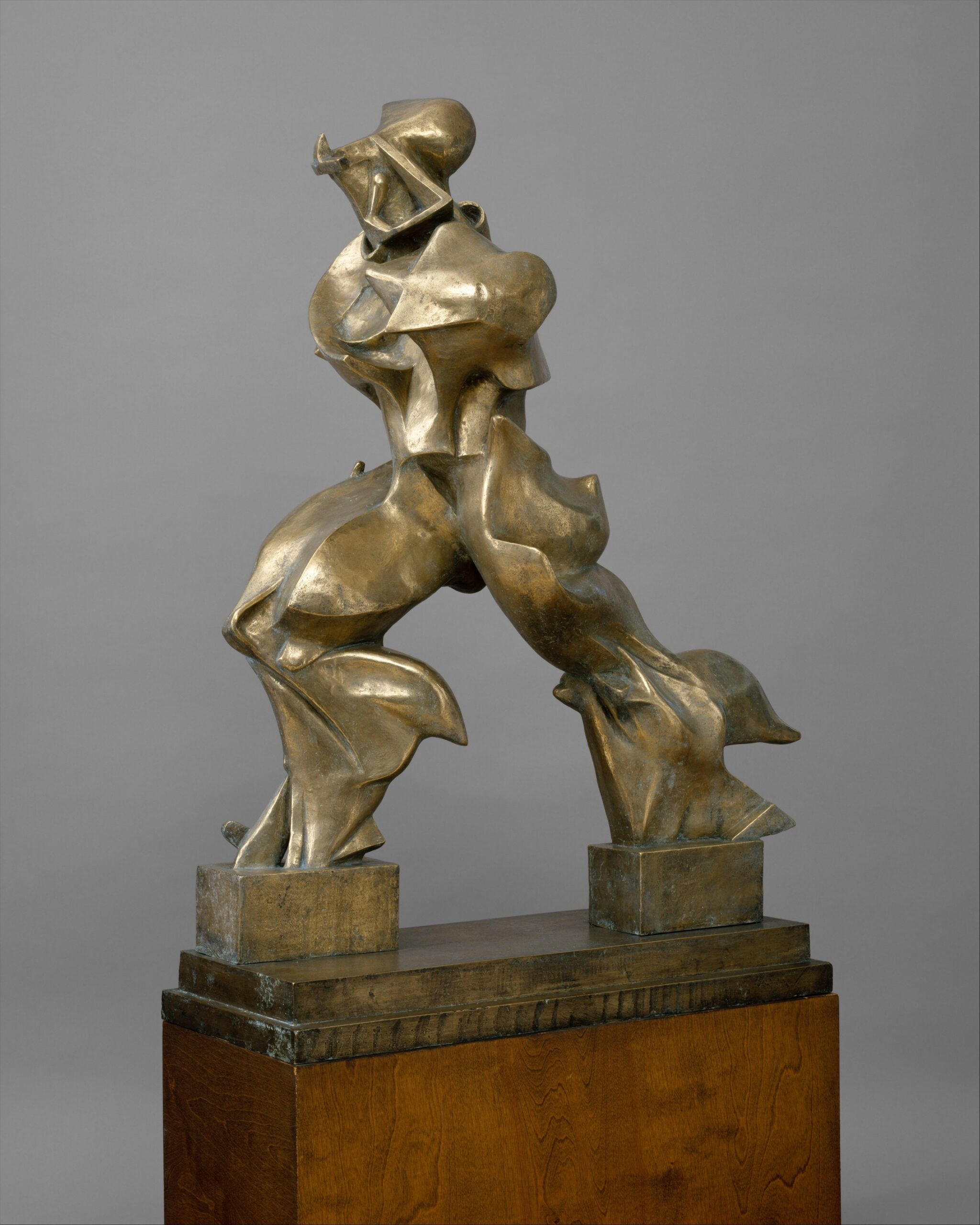
Bronze, 121.3 × 88.9 × 40 cm, The Metropolitan Museum of Art, New York
Antonio Sant’ Elia, Train Station and airplanes, 1914
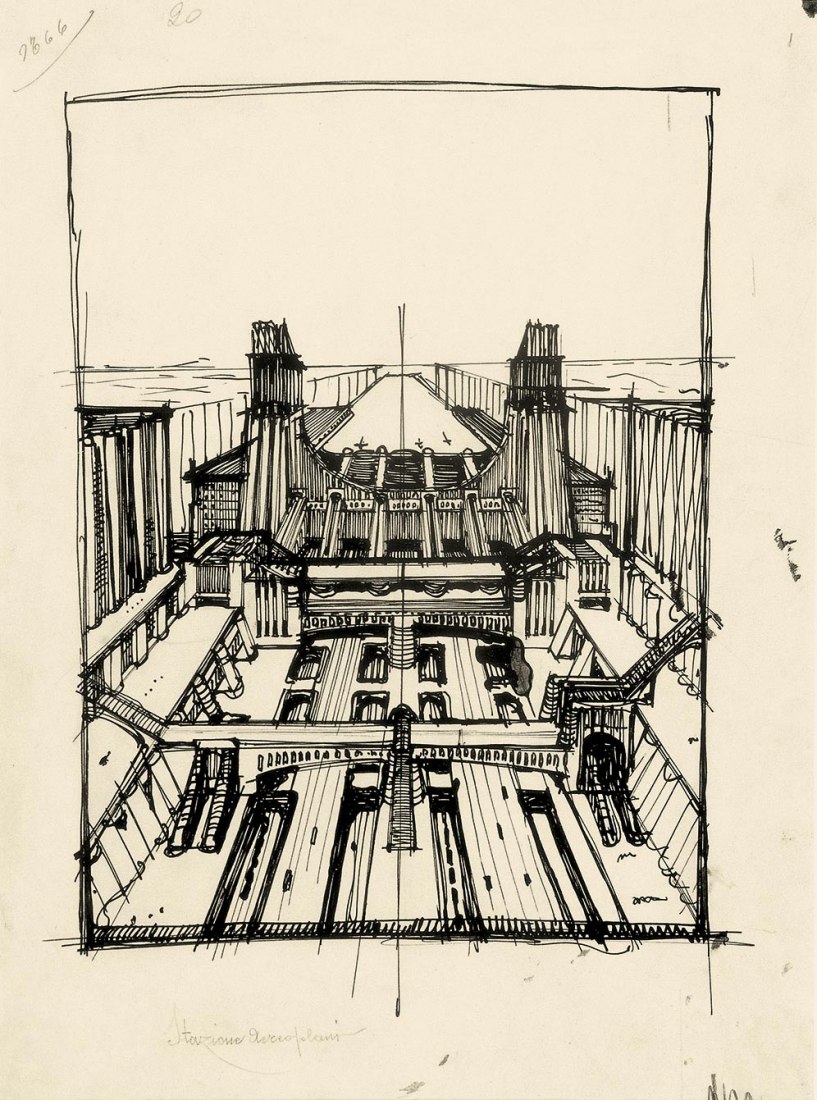
Pencil and ink on paper, 27.9 x 20.9 cm, Pinacoteca Civica, Como
A larger list of Futuist paintings and artwork is shown below:
- Unique Forms of Continuity in Space (Umberto Boccioni)
- Dynamism of a Dog on a Leash (Giacomo Balla)
- Ascending Forms (or Ascending Forces) (Gerardo Dottori)
- Ballerina in Blue (Gino Severini)
- Primavera Umbria (Gerardo Dottori)
- Dynamism of a Car (Luigi Russolo)
- Dynamic Decomposition (Umberto Boccioni)
- Horizontal Volumes (Umberto Boccioni)
- Memories of a Night (Luigi Russolo)
- Futuristic woman (David Burliuk)
- Serie di n. 8 rinoceronti (Fortunato Depero)
- Ciò che mi ha detto il tram (Carlo Carrà)
- Scienza contro oscurantismo (Giacomo Balla)
- Velocità d’automobile (Velocità n. 1) (Giacomo Balla)
- Solidity of Fog (Luigi Russolo)
- Dinámica del viento (Emilio Pettoruti)
- Cannoni in azione (Gino Severini)
- Urban Landscape with Chimneys (Mario Sironi)
- Dynamism of a Cyclist (Umberto Boccioni)
- il Trittico della Velocità
- The Voice of the City of New York Interpreted
- Aurora Volando (Gerardo Dottori)
- The Funeral of the Anarchist Galli (Carlo Carrà)
- Abstract Speed + Sound (Giacomo Balla)
- Simultaneous Visions (Umberto Boccioni)
- Materia (Umberto Boccioni)
- States of Mind I
- Carica di lancieri (Umberto Boccioni)
- Sea = Dancer (Gino Severini)
- Rotazione di ballerina e pappagalli (Fortunato Depero)
- States of Mind II
- Movimento d’uccello (Fortunato Depero)
- Festa della sedia (Fortunato Depero)
- The Soul of the Soulless City (Christopher R. W. Nevinson)
- The Street Pavers (Umberto Boccioni)
- Dynamism of a Soccer Player (Umberto Boccioni)
- The Miracle of Light While Flying (Gerardo Dottori)
- Street Light (Giacomo Balla)
- Numbers in Love (Giacomo Balla)
- The Mud Bath (David Bomberg)
- Paesaggio Aereo (Gerardo Dottori)
- Dancer in Pigalle (Gino Severini)
- The Brooklyn Bridge
- Aurora sul Golfo (Gerardo Dottori)
- Sotto il pergolato a Napoli (Umberto Boccioni)
- The Voice of the City of New York Interpreted (Joseph Stella)
- Iridescent Interpenetration (Giacomo Balla)
- Futurist Composition (Joseph Stella)
- Italy Between the Arts and Sciences (Mario Sironi)
- Flags at the altar of the Motherland (Giacomo Balla)
- A horse-lightning (David Burliuk)
Futurism in music
Futurist ideas had an impact on music theory and composition as well as on the development of new musical instruments. Musicologist and composer Francesco Balilla Pratella was a member of the Futurist movement. His contributions to avant-garde music theory are reflected in the Manifesto of Futurist Musicians published in 1910, in the Technical Manifesto of Futurist Music published in 1911, and in The Destruction of Quadrature published in 1912. Futurist musicians advocated abandoning traditional forms of academic music education as well as moving away from the dominant operatic tradition in Italy. Luigi Russolo is another important author in the field of music theory. Russolo published the revolutionary book The Art of Noises in 1913. In it, Russolo explores a new sound palette that includes the sounds and noises inherent in the urban landscape.
Brothers Luigi and Antonio Russolo constructed new instruments which they named intonarumori. These instruments were acoustic noise generators that allowed the performer to control the dynamics and pitch of several different types of noises. Artists influenced by futurist music theory are Igor Stravinsky, Edgard Varèse, George Antheil, Arthur-Vincent Lourié, Mikhail Gnesin, and Alexander Goedicke.
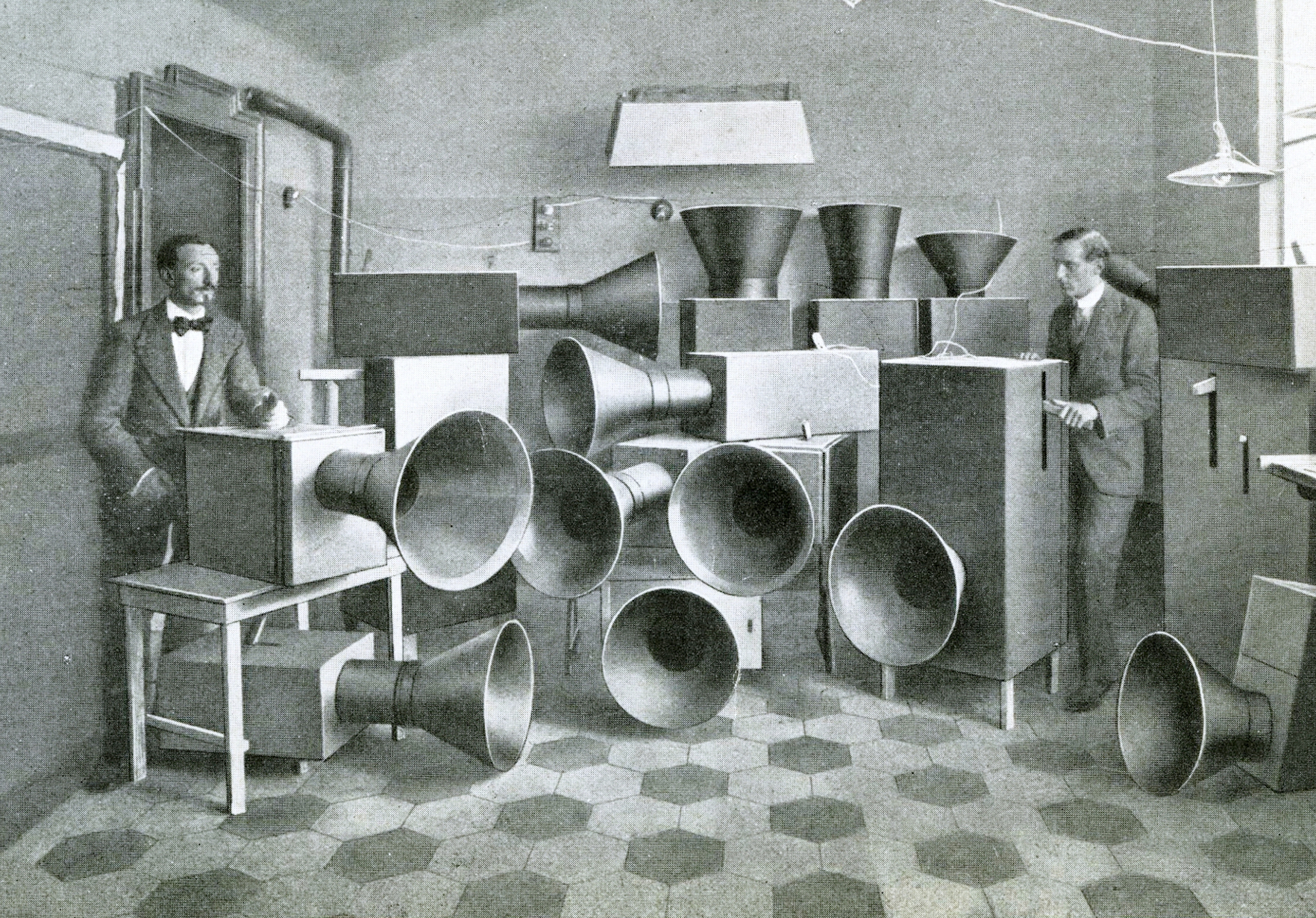
Futurism in literature
Futurism encouraged revolutionary changes in the field of literature. Futurists considered traditional lyrical and epic literature as well as the genres within them to be anachronistic. In the subversive approach the Futurists had, they ridiculed the most valued prose form, which is the novel. Futurist literature was supposed to rest on seven principles, namely intuition, analogy, irony, abolition of syntax, metrical reform, onomatopoeia, and essential/synthetic lyricism. Futurists considered it necessary to change the syntax and economize the language, which must be concise and practical. Filippo Tommaso Marinetti formulated the idea of the language of the modern age in the manifesto Destruction of Syntax–Wireless Imagination–Words-in-Freedom. Such a language is devoid of adjectives and adverbs and introduces mathematical and musical symbols into use. The futurist language would rest on verbs that would always appear in the infinitive as well as on the frequent use of onomatopoeia.
Marinetti’s concept known as words in freedom opened up space for a new relationship between text and visual material. These two contents are no longer opposed but united through the idea of visual poetry. New typographical solutions made it possible for the form of the poem to look completely unconventional. This approach meant a change not only in the domain of the visual but innovation in the position of the reader who now needs to look “at” and “through” the printed text.
Futurism in theater
For the Futurists, the theater was a place of great importance. As Marinetti together with Emilio Settimelli and Bruno Corra writes in The Futurist Synthetic Theater (1915), 90% of Italians come to the theater and the Futurist war spirit should be encouraged there. Synthetic in the futurist theater should have been the reduction of the dramatic text to basic lines that represent the idea of the drama. As they state in the manifesto, our very modern cerebral definition of art according to which no logic, no tradition, no aesthetic, no technique, no opportunity can be imposed on the artist’s natural talent; he must be preoccupied only with creating synthetic expressions of cerebral energy that have the absolute value of novelty. Parody and vaudeville were very close to the Futurists. Futurists perceived the theatrical event through the capacity of the overall theater environment to influence the viewer. That ambience was created by the actors on stage and the audience in equal measure. The Futurists believed that an artist completely freed from the legacy of theater history could excite and influence an audience.
Futurism in film
The Futurists were very close to the new artistic forms of film and photography. The futurist period of Italian avant-garde cinema lasted from 1916 to 1919. Notable authors from this period are Arnaldo Ginna, Anton Giulio Bragaglia, and Ivo Illuminati. The futurist film is characterized by anti-naturalism as well as the aesthetics of intense contrast of black and white geometrized surfaces. The only surviving film from this period is Thaïs, directed by Anton Giulio Bragaglia in 1917. The futurist film had a great influence on German Expressionism. This influence is clearly visible in Fritz Lang’s Metropolis from 1927.
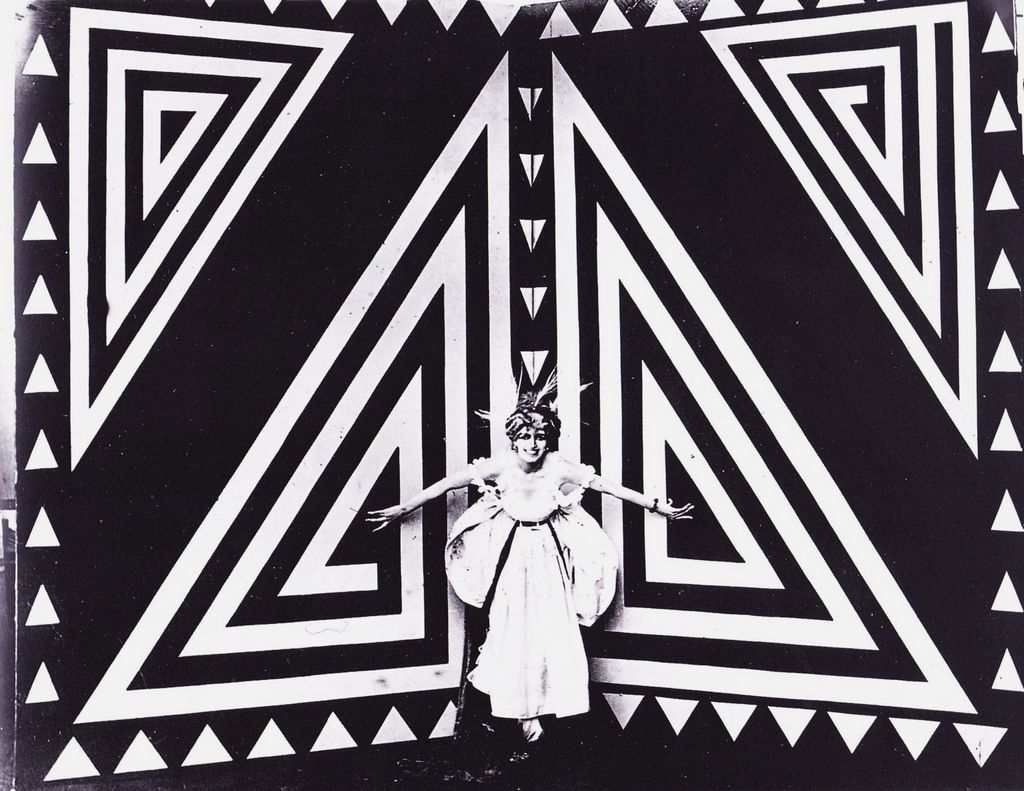
Futurism in architecture
The architecture was one of the important fields for the futurist experiment. Tendencies towards wider social change, the emancipation of the masses, and the redefinition of urban and rural spaces found their explicit application in architecture. The first and most significant futurist manifesto in the field of architecture is the Manifesto of Futurist Architecture, by Antonio Sant’Elia published in 1914. Antonio Sant’Elia was the most influential futurist theorist of architecture. The manifesto he wrote defined the value and aesthetic framework of futurist architecture, which is based on discontinuity in relation to the theories of Vitruvius, Vignola, and Sansovino. The history of architecture and established patterns of construction were a burden that Sant’Elia considered an obstacle to the formation of modern architectural expression. The conditions that dictate architectural trends must be modernity, functionality, and economy required by modern housing.
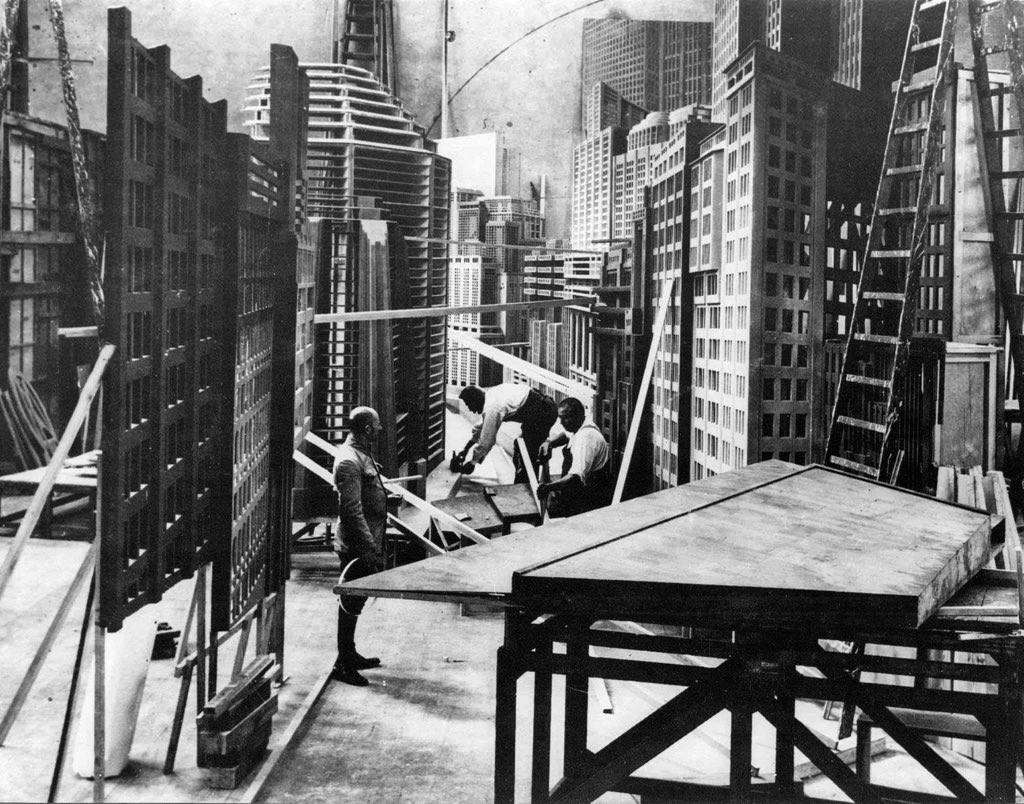
Futurism as an international phenomenon
Futurism, as a philosophy and spectrum of aesthetic principles, spread very quickly in international circles. At first, in the European context, futurism found a good response in Germany, the Czech Republic, France, Hungary, and Yugoslavia. Through the Portuguese avant-garde scene, futurist ideas reached South America – Brazil, and Argentina. In Russia, futurism is developing as cubo-futurism. The Cubo-futurist avant-garde movement brought together numerous artists who would redefine modern art through later work within suprematism and constructivism. The influence of futurism is also noticeable in the Japanese interwar art scene.
Futurism vs. Cubism
Gino Severini was the first to get acquainted with the cubist methods that the Futurists soon adopted. Cubist fragmentation of scenes, as well as experimentation with perspective, were crucial to the futuristic painting experiment. Given the dominant themes that the Futurists dealt with – the development of technology, industry, traffic, and scenes of city life – cubist geometrization as a basis paved the way for the establishment of a new language of futuristic painting. Dynamism was the primary value that the Futurists sought to formulate through their works, and in that aspiration, they differed from the Cubists. Accordingly, the static nature of the cubist scene that decomposes into immobility was not a characteristic that the Futurists continued to develop.
Futurism vs. Modernism
Along with Cubism, the painting tradition of early Modernism had the greatest influence on Futurism. Specifically, it is about the post-impressionist technique of Divisionism. This technique is based on applying pure paint to the canvas without prior mixing on the palette. In such a pure form, the paint is applied, building harmonious complementary relations. The visual language created by Futurists based on post-impressionism and cubism influenced several modernist movements that emerged in the following years such as Surrealism, Cubo-futurism, Constructivism, Rayonism, and Precisionism.
Degenerate Art
At the very end of the First World War, the Futurists moved from subcultural frameworks into the official streams of Italian culture. By founding the Futurist Political Party, which soon became part of the National Fascist Party, Marinetti became one of the leading intellectuals in fascist circles. The idea of transforming the dominant cultural model in Italy was not realized. Futurist architects played a significant role in the post-war reconstruction, while painters and designers created propaganda posters and monumental portraits of Duce made in the authentically futurist aeropainting technique. The social climate quickly became more rigid and militant, and with the approach of Italy to Germany at the dawn of the Second World War, the German term Entartete Kunst or degenerate art was introduced into the public discourse. The term denoted decadent and perverted tendencies in art as interpreted by the Nazis. Futurism was one of the many avant-garde movements that was characterized as degenerate and was removed from the Italian cultural scene at the end of the thirties.
